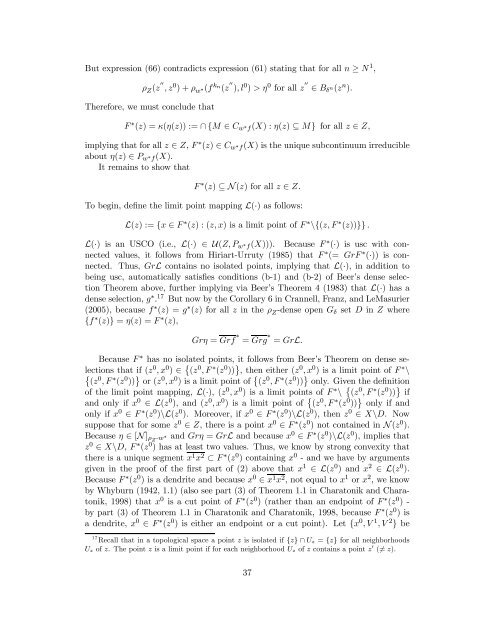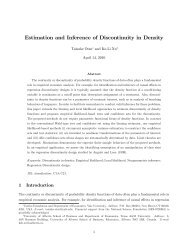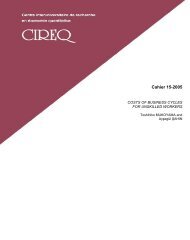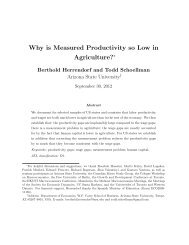In particular, for all n ≥ N 0 <strong>and</strong> for (z 0 ,l 0 ) ∈ Gr ρZ ×w ∗f ∗[ρ Z (z n ,z 0 )+ρ w ∗(f k n(z n ),l 0 )] > η 0 .Let δ n := ρ Z (z 0 ,z n )+ 1 n . Because zn →ρZz 0 , δ n > 0 <strong>and</strong> δ n ↓ 0, there is an integerN 1 ≥ N 0 so that for all n ≥ N 1 δ n < min{δ 0 , η02 } <strong>and</strong> B δ n (z n ) ⊂ B δ 0(z 0 ). Thus, ifn ≥ N 1 , then for all z 00 ∈ B δ n(z n ) ⊂ B δ 0(z 0 ), f k n(z 00 ) ∈ B ε 0(x 0 ), <strong>and</strong> we have for alln ≥ N 1 <strong>and</strong> for all z 00 ∈ B δ n(z n ),[ρ Z (z 00 ,z)+ρ w ∗(f kn (z 00 ),x)] > η 0 for all (z,x) ∈ Gr ρZ ×w ∗f ∗ .In particular, we have for all n ≥ N 1 <strong>and</strong> for all z 00 ∈ B δ n(z n ),ρ Z (z 00 ,z 0 )+ρ w ∗(f kn (z 00 ),l 0 ) > η 0 where (z 0 ,l 0 ) ∈ Gr ρZ ×w ∗f∗ . (61)Also note that for n ≥ N 1 ,wehavebothB δ n(z n ) ⊂ B δ 0(z 0 ) <strong>and</strong> z 0 ∈ B δ n(z n ).Thusfor n ≥ N 1 , B δ n(z n ) is a neighborhood of z 0 contained in B δ 0(z 0 ). Because B δ n(z n )is also a neighborhood of z n (contained in B δ 0(z 0 )), by the equi-quasicontinuity ofthe sequence, {f k n} n (see Lemma 20 in Appendix 1), we have for η06> 0, an integerN 2 ≥ N 1 , <strong>and</strong> a nonempty open set W n ⊂ B δ n(z n ) such that for all ν ≥ max{n, N 2 }<strong>and</strong> n ≥ N 1ρ w ∗(f kν (z 00 ),f kν (z n )) < η06 for all z00 ∈ W n ⊂ B δ n(z n ). (62)By pointwise convergence, there is an integer N 3 ≥ N 2 such that if ν ≥ max{n, N 3 },thenρ w ∗(f kν (z n ),f ∗ (z n )) < η06 . (63)Moreover, because f ∗ (z n ) → l 0 , there is an integer N 4 ≥ N 3 such that if n ≥ N 4 ,ρw ∗thenρ w ∗(f ∗ (z n ),l 0 ) < η06 . (64)We have, therefore, for all ν ≥ n ≥ N 4 <strong>and</strong> for all z 00 ∈ W n ⊂ B δ n(z n ) ⊂ B δ 0(z 0 ))ρ w ∗(f kν (z 00 ),l 0 )≤ ρ w ∗(f kν (z 00 ),f kν (z n )) + ρ w ∗(f kν (z n ),f ∗ (z n )) + ρ w ∗(f ∗ (z n ),l 0 ) < η02 , (65)for all z 00 ∈ W n ⊂ B δ n(z n ) ⊂ B δ 0(z 0 ).Finally, given that δ n < min{δ 0 , η02 }, there is an integer N 5 ≥ N 4 such that forall n ≥ N 5 <strong>and</strong> for all z 00 ∈ B δ n(z n ), ρ Z (z 00 ,z 0 ) < η02 .Thus,forn ≥ N 5 ,wehaveW n ⊂ B δ n(z n ) ⊂ B δ 0(z 0 ),<strong>and</strong> for all z 00 ∈ W n , ρ Z (z 00 ,z 0 ) < η02 , implying that for all ν ≥ n ≥ N 5 ,[ρ Z (z 00 ,z 0 )+ρ w ∗(f k ν(z 00 ),l 0 )] < η 0 for all z 00 ∈ W n ⊂ B δ n(z n ) ⊂ B δ 0(z 0 ). (66)36
But expression (66) contradicts expression (61) stating that for all n ≥ N 1 ,ρ Z (z 00 ,z 0 )+ρ w ∗(f k n(z 00 ),l 0 ) > η 0 for all z 00 ∈ B δ n(z n ).Therefore, we must conclude thatF ∗ (z) =κ(η(z)) := ∩ {M ∈ C w ∗ f(X) :η(z) ⊆ M} for all z ∈ Z,implying that for all z ∈ Z, F ∗ (z) ∈ C w ∗ f(X) is the unique subcontinuum irreducibleabout η(z) ∈ P w ∗ f(X).It remains to show thatF ∗ (z) ⊆ N (z) for all z ∈ Z.To begin, define the limit point mapping L(·) as follows:L(z) :={x ∈ F ∗ (z) :(z,x) is a limit point of F ∗ \{(z,F ∗ (z))}} .L(·) is an USCO (i.e., L(·) ∈ U(Z, P w ∗ f(X))). Because F ∗ (·) is usc with connectedvalues, it follows from Hiriart-Urruty (1985) that F ∗ (= GrF ∗ (·)) is connected.Thus, GrL contains no isolated points, implying that L(·), in addition tobeing usc, automatically satisfies conditions (b-1) <strong>and</strong> (b-2) of Beer’s dense selectionTheorem above, further implying via Beer’s Theorem 4 (1983) that L(·) has adense selection, g ∗ . 17 But now by the Corollary 6 in Crannell, Franz, <strong>and</strong> LeMasurier(2005), because f ∗ (z) =g ∗ (z) for all z in the ρ Z -dense open G δ set D in Z where{f ∗ (z)} = η(z) =F ∗ (z),Grη = Grf ∗ = Grg ∗ = GrL.Because F ∗ has no isolated points, it follows from Beer’s Theorem on dense selectionsthat if (z 0 ,x 0 ) ∈ © (z 0 ,F ∗ (z 0 )) ª ©, then either (z 0 ,x 0 ) is a limit point of F ∗ \(z 0 ,F ∗ (z 0 )) ª or (z 0 ,x 0 ) is a limit point of © (z 0 ,F ∗ (z 0 )) ª only. Given the definitionof the limit point mapping, L(·), (z 0 ,x 0 ) is a limit points of F ∗ \ © (z 0 ,F ∗ (z 0 )) ª if<strong>and</strong>onlyifx 0 ∈ L(z 0 ),<strong>and</strong>(z 0 ,x 0 ) is a limit point of © (z 0 ,F ∗ (z 0 )) ª only if <strong>and</strong>only if x 0 ∈ F ∗ (z 0 )\L(z 0 ). Moreover, if x 0 ∈ F ∗ (z 0 )\L(z 0 ),thenz 0 ∈ X\D. Nowsuppose that for some z 0 ∈ Z, thereisapointx 0 ∈ F ∗ (z 0 ) not contained in N (z 0 ).Because η ∈ [N ] ρZ -w ∗ <strong>and</strong> Grη = GrL <strong>and</strong> because x0 ∈ F ∗ (z 0 )\L(z 0 ), implies thatz 0 ∈ X\D, F ∗ (z 0 ) has at least two values. Thus, we know by strong convexity thatthere is a unique segment x 1 x 2 ⊂ F ∗ (z 0 ) containing x 0 - <strong>and</strong> we have by argumentsgiven in the proof of the first part of (2) above that x 1 ∈ L(z 0 ) <strong>and</strong> x 2 ∈ L(z 0 ).Because F ∗ (z 0 ) is a dendrite <strong>and</strong> because x 0 ∈ x 1 x 2 ,notequaltox 1 or x 2 , we knowby Whyburn (1942, 1.1) (also see part (3) of Theorem 1.1 in Charatonik <strong>and</strong> Charatonik,1998) that x 0 is a cut point of F ∗ (z 0 ) (rather than an endpoint of F ∗ (z 0 ) -by part (3) of Theorem 1.1 in Charatonik <strong>and</strong> Charatonik, 1998, because F ∗ (z 0 ) isa dendrite, x 0 ∈ F ∗ (z 0 ) is either an endpoint or a cut point). Let {x 0 ,V 1 ,V 2 } be17 Recall that in a topological space a point z is isolated if {z} ∩ U z = {z} for all neighborhoodsU z of z. Thepointz is a limit point if for each neighborhood U z of z contains a point z 0 (6= z).37
- Page 5: cally approximated by continuous fu
- Page 12 and 13: the set x 0 x 1 ∈ C w ∗ f(X) is
- Page 14 and 15: defined on some probability space,
- Page 16 and 17: contains at most one arc (i.e., ¯
- Page 18 and 19: into the collection of Ky Fan sets
- Page 20 and 21: 3.1 Best Response MappingsLetting p
- Page 22 and 23: 4.1 Nikaido-Isoda FunctionsWith eac
- Page 24 and 25: Because Φ(z) × Φ(z) is w ∗ ×
- Page 26 and 27: where for all n, C n ∈ S E n,then
- Page 28 and 29: Definition 4 (The 3M Property - The
- Page 30 and 31: Given (48) and the fact that for n
- Page 32 and 33: We note that if m(z) ∈ P w ∗ f(
- Page 34 and 35: 6.3 AK Convergence of Minimal Nash
- Page 36 and 37: and Gr ρZ ×w ∗f ∗ (·) is the
- Page 40 and 41: the cutting defined by the cut poin
- Page 42 and 43: According to our main result, under
- Page 44 and 45: By our main approximation result, f
- Page 46 and 47: 9 Appendix 1: USCO FundamentalsIn t
- Page 48 and 49: 9.3 Equi-QuasicontinuityIn order to
- Page 50 and 51: 9.5 Dense SelectionsFor each F ∈
- Page 52 and 53: 10 Appendix 2: The Proof of Lemma 8
- Page 54 and 55: Noting that if E ∈ D eE ,thenn eE
- Page 56 and 57: 12 Appendix 4: The Proof That All K
- Page 58 and 59: Letting E 1 =[E 1 \(X × U 2 )] ∪
- Page 60 and 61: [10] Bryant, V. W. (1970) “The Co
- Page 62: [42] Ward, L. E., Jr. (1958) “A F






